Busy lizzie: location, care & the most beautiful varieties
The busy lizzie lives up to its name by diligently forming colourful flowers throughout the summer.
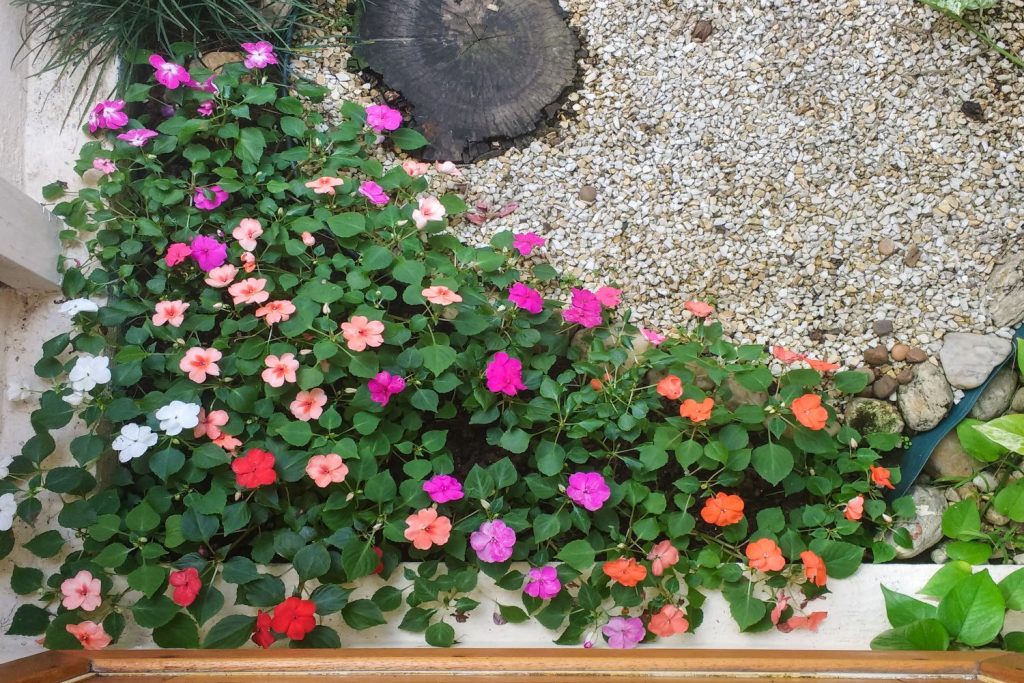
The busy lizzie (Impatiens walleriana) paints a scene in any garden with its many colourful flowers. Although they are grown as annuals, you can avoid buying new busy lizzies every year by propagating them yourself. Read on to learn how and get some tips and tricks for looking after impatiens.
Contents
Busy Lizzie: origin and characteristics
Also called balsams, sultanas or simply impatiens, busy lizzies belong to the Impatiens genus and Balsaminaceae family. They are evergreen herbaceous plants that are native to eastern Africa from Kenya to Mozambique. These plants are popular for their many colourful flowers and compact carpet-like growth habit. The ovate leaves are alternate and slightly toothed. Depending on the variety, the leaves are dark green on the upper side and pink or red underneath. The flowers each have five stamens and are zygomorphic, meaning they are bilaterally symmetrical. Depending on the variety, they are 3 to 4cm wide and bloom in varying colours. An Impatiens walleriana grows 20 to 40cm tall and forms smooth 2cm large seed pods.

Tip: Impatiens is Latin for “impatient” or “sensitive” – this name refers to the delicate seedpods typical of Impatiens that burst open when touched, spreading the seeds far and wide; in botany, this mechanism is referred to as explosive dehiscence. As the seeds ripen, the pressure inside the seedpod increases, eventually causing the pod to burst open and expel the seeds.
What is the difference between common busy lizzies and New Guinea busy lizzies? The New Guinea impatiens, also called sun impatiens, is a hybrid of busy lizzie and other impatiens species. A New Guinea busy lizzie has the distinct advantage of being resistant to downy mildew, which gives common busy lizzies a hard time. The difference between the plants can be easily recognised in their appearance. New Guinea impatiens has larger flowers and narrow pointed leaves. It also generally has a more vigorous growth habit than the common busy lizzie.

Are busy lizzies perennial?
Busy lizzies are, by nature, perennials. However, because they are sensitive to low temperatures, they are almost always grown as annuals in the UK. If you want to keep your impatiens as a perennial, it is necessary to overwinter the plant in a protected spot. Keeping a busy lizzie happy and healthy as a perennial is not a piece of cake, which is why impatiens are generally grown as annuals by most hobby gardeners.
When do busy lizzies flower?Busy lizzies typically show off their colourful flowers between April and September.
The most beautiful varieties
Busy lizzie varieties come in all sorts of colours and are named accordingly. For example, the Impatiens walleriana ˈAccent Premiumˈ includes ‘Whiteˈ, ˈBurgundyˈ and ˈViolet Starˈ cultivars, among others.
Busy Lizzie varieties
- Impatiens walleriana ˈAccent Premiumˈ: this variety blooms in white, lilac, crimson, orange, pink, red and purple. It grows compact at 15 – 20cm high.
- Impatiens walleriana ˈFiesta Oleˈ: these double busy lizzies radiate orange, purple, pink, red, purple and white, while growing compactly to 20 – 30cm tall.
- Impatiens walleriana ˈAccent Starˈ: this variety blooms in orange, purple, pink, red and purple with white star-shaped centres. It grows compactly to 15 – 20cm high.
- Impatiens walleriana ˈSuper Elfinˈ: this busy lizzie blooms pastel pink, red, purple, white and sometimes bicolour. With a height of 15 – 20cm, it has a compact-bushy growth habit.
Tip: if you plant different varieties close to each other, collect their seeds in autumn and sow them in spring, you will get a fun mix of colours.
New Guinea busy lizzie varieties
- Impatiens New Guinea Group ‘Tamarinda Max Lavender’: this hardy, lavender-coloured variety has a long blooming season. It grows up to 60cm tall and wide; accordingly, the plant spacing should be at least 50cm.

- Impatiens New Guinea Group ‘Divine Violet’: has bright violet-purple flowers that bloom from summer through to autumn. It can thrive in spots that are semi-shady as well as in full shade and grows smaller than some other New Guinea impatiens, measuring at about 40cm tall.
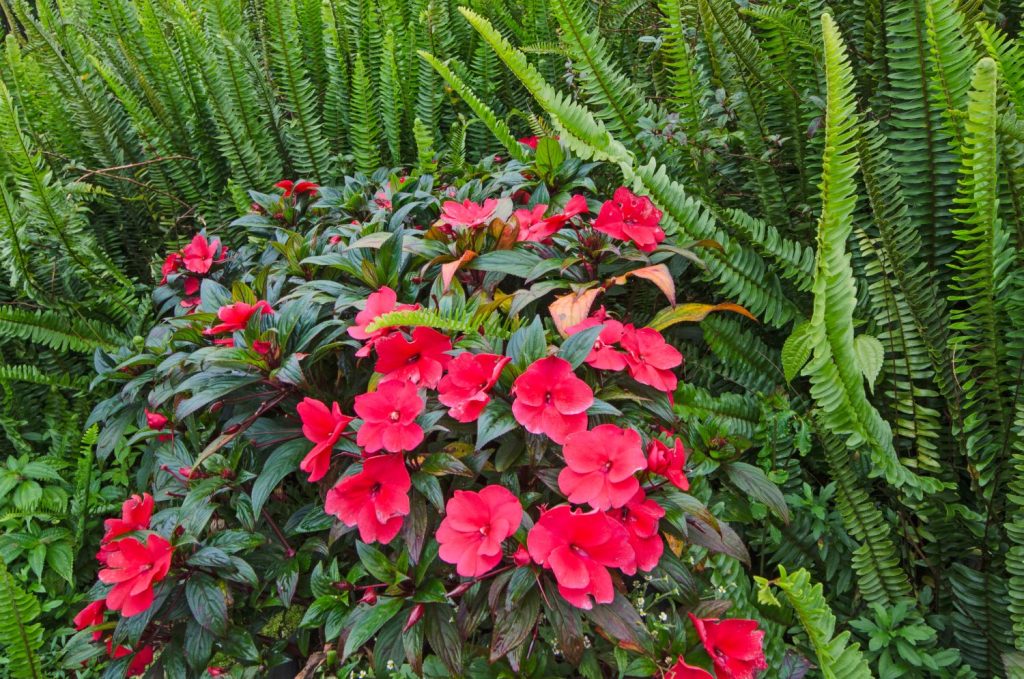
- Impatiens New Guinea Group ‘Magnum Fire’: this New Guinea impatiens grows upright and quite large at up to 60cm tall. This Magnum series variety also branches abundantly and forms many flowers in mid to late summer. Due to its size, it is commonly grown on its own.
- Impatiens ‘Paradise Moorea’: this compact New Guinea impatiens grows just 20cm high and blooms in white early in the year.
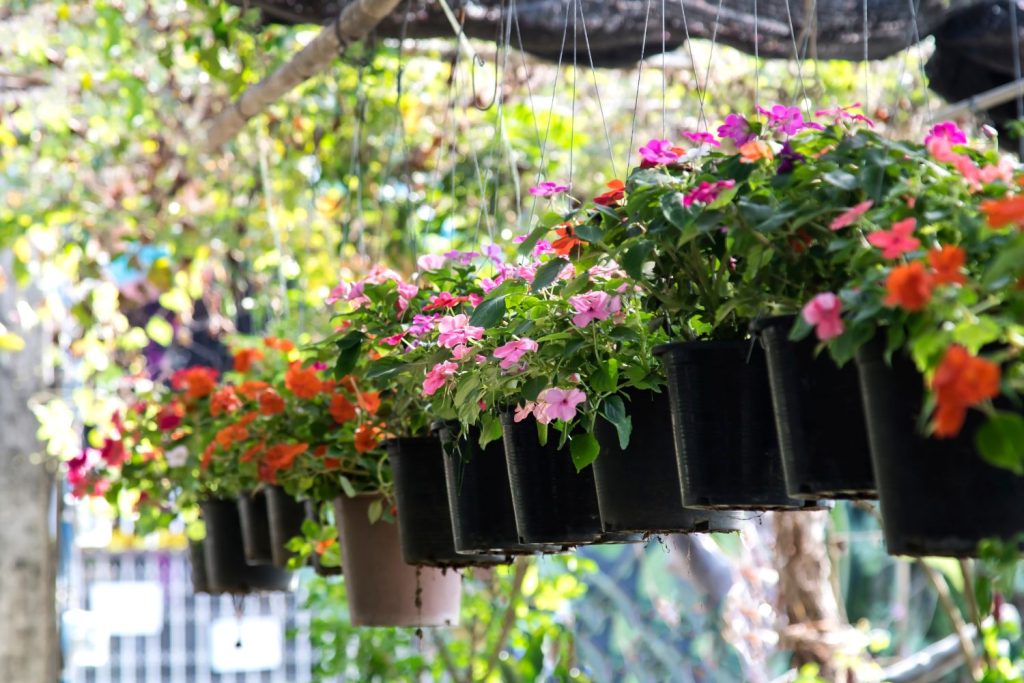
Planting busy Lizzie
In the wild, the balsam grows in moist shady places like coastal rainforests. Ideally, you want to match those conditions as close as possible for your busy lizzie. Also, Impatiens walleriana plants look most attractive when planted in small groups.
The right location
Busy lizzies need a semi-shady to shady location, which is preferably protected from the wind. Avoid direct sunlight; too much direct sunlight burns the leaves and flowers of busy lizzies, causing brown spots. Conversely, if the location is too shady, the plants will form fewer flowers. Impatiens wallerianas grow best in well-drained, humus-rich soil, and they tolerate calcareous, slightly acidic soil. They do well in or along the edge of woods, where they get plenty of shade.

Do snails and slugs eat busy lizzies? No, busy lizzies are slug and snail resistant plants.
Sowing and planting
The best time to plant busy lizzies in the bed or in a pot is after the last frosts in spring. If you plan on planting yours in a pot or planter, choose a container that is just large enough for the roots. With less space for the roots to grow, your busy lizzie plant will put its energy towards producing more flowers.
Busy lizzies love water but not waterlogging. So, when planting busy lizzies in pots, be sure to add a drainage layer such as expanded clay. As for soil, we suggest using a nutrient-rich, well-drained, high-quality potting compost such as our Plantura Organic Flower Compost; it has everything impatiens need to support lush and long-lasting flower growth.
How to plant an Impatiens walleriana in a garden bed:
- After finding an ideal location, dig a planting hole slightly larger than the plant’s container
- Place your busy lizzie in the planting hole so that the lowest leaves almost touch the ground
- Mix some compost or slow-release fertiliser into the excavated soil to give the plant some extra nutrients
- Fill the gaps around the plant’s roots with the soil mixture and press it down lightly
- After planting, always keep the busy lizzie’s soil slightly moist
Tip: work in some slow-release fertiliser granules like our organic Plantura Flower Food to provide the busy lizzies with all the nutrients they need to flower abundantly. Plus, our flower food contains no animal products.
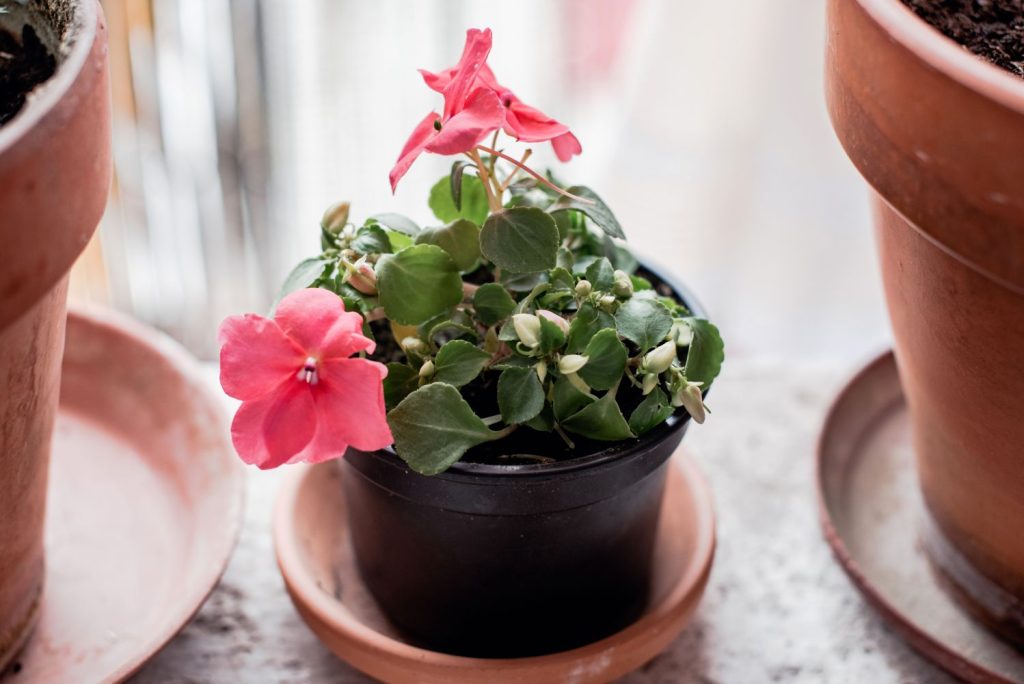
Rather than buying busy lizzie plug plants, you can also sow the seeds yourself. The best time to start sowing is in February or March.
Sowing busy lizzies:
- Fill seed trays with seedling compost such as our Plantura Organic Herb & Seedling Compost
- Place the impatiens seeds on top of the soil (busy lizzie seeds need light to grow, so do not cover them with soil)
- Moisten the soil and cover the seed tray with a transparent cover
- Leave the tray in a well-lit area at about 20 °C for 10 – 14 days
- When the seeds germinate, remove the cover
- Once the seedlings have 4 pairs of true leaves, remove the top 2 to encourage more branching and bushier growth
- After the last frosts in spring, plant your balsam outside

- Perfect for herbs as well as sowing, propagating & transplanting
- For aromatic herbs & healthy seedlings with strong roots
- Peat-free & organic soil: CO2-saving composition
Busy lizzie care
Busy lizzies need a generous watering regularly. However, despite this requirement, they do not tolerate waterlogging. Always ensure that any excess water drains away.
Additionally, busy lizzies require a lot of nutrients. We recommend using an organic slow-release fertiliser for busy lizzies planted in a garden bed; just add some to the planting hole in spring. For potted busy lizzies, we suggest using a liquid fertiliser, such as our Plantura Liquid Flower Food; apply the liquid fertiliser fortnightly when watering to provide your impatiens with all the nutrients they need.
Tip: encourage your impatiens to grow new flowers by deadheading any wilted flowers and removing yellow leaves and old stalks.

How to overwinter busy lizzies?
Busy lizzies are extremely sensitive to frost. In fact, they experience cold damage as soon as temperatures drop below 10 °C, so overwintering them can be a challenge. If you do want to overwinter your busy lizzie, place it in a bright location at 10 to 15 °C as early as September. During winter, only water impatiens moderately, and spray the plant from time to time with rainwater to keep the leaves fresh. Never allow the soil to dry out completely. While overwintering, continue fertilising your busy lizzie but only every 2 months and with half the amount of fertiliser. After the last frosts in May, place your perennial bloomer outside again. At this time, prune your busy lizzie back by a third to encourage new sprouts and bushier growth.
Propagation
If you are not interested in putting in the effort to overwinter a busy lizzie, another option is to propagate new busy lizzies from seeds. The first step is to collect the seeds. As mentioned previously, mature seed capsules burst open when touched, so cup your hand around the capsule to catch the seeds that are expelled. If the seed pod does not burst open when you touch it, the seeds are not yet mature. Once you have collected some seeds, spread them out to dry on a flat surface in a dark dry room.
Tip: try storing your seeds in a matchbox – it absorbs and releases residual moisture from the seeds. If you keep your seeds in a glass jar, add a piece of paper to absorb any residual moisture.
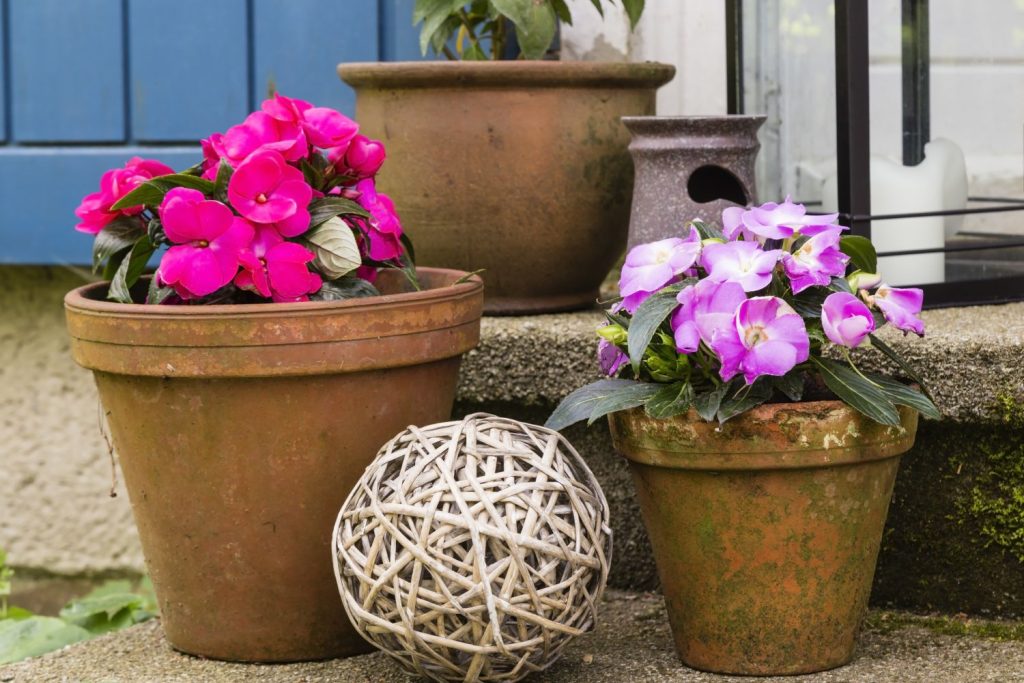
Busy lizzies can also be propagated from cuttings. Locate a healthy 5 to 10cm long shoot and cut it off of the mother plant. Place the cutting in a glass of water and keep it at room temperature for 3 to 4 weeks. Once the cutting has formed roots, gently transfer it to a container with soil. Keep it in a spot with high humidity until new leaves sprout.
Are busy lizzies poisonous?
No, busy lizzies are non-toxic to humans and pets. Nevertheless, these ornamental plants are not suitable as food or fodder, as they do not taste good and have no nutritional value.


















